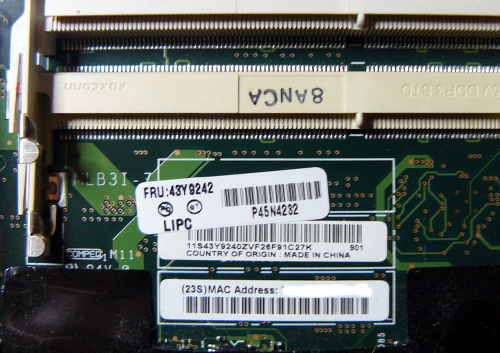Introduction (GM45+e1000)
This section is applicable to all supported laptops with the mobile 4 series chipset (as shown in $ lspci) that use the e1000 ethernet controller (e.g. T400, X200). The R500 is an exception to this as it does not use the built-in e1000.
On all these laptops, the MAC address for the built-in gigabit ethernet controller is stored inside the flash chip, along with Canoeboot and other configuration data. Therefore, installing Canoeboot will overwrite it.
Thus, for these laptops, prebuilt Canoeboot images already contain a generic MAC address in the GbE region. Unless you change it, your computer will boot and use it. This can lead to network problems if you have more than one Canoeboot computer on the same layer2 network (e.g. on the same network switch).
To prevent these address clashes, you can either modify prebuilt Canoeboot to use an address of your own choosing or you can change the address in your operating system’s boot scripts.
In either case, it is a good idea to write down the address that your computer originally had.
Obtaining the existing MAC address
The existing MAC address may be obtained by the following methods:
Run
ip linkorifconfigin a terminal/console/shell; find your ethernet device (e.g., enpXXX or ethXXX), and look for a set of 12 colon-delimited hexadecimal digits. For example:00:f3:f0:45:91:fe.`$ ip link
… link/ether ??:??:??:??:??:?? brd …
Alternatively:
ifconfig
… ether ??:??:??:??:??:?? txqueuelen …
Otherwise you can read the white label that is often found on the motherboard under the memory sticks:

The MAC address is usually listed on the laptop chassis as well. This one will be incorrect if the motherboard was changed and the stickers were not updated.
Changing the MAC address in the operating system
There are three portable ways of doing so:
Using the new iproute2 package:
ip link set
down ip link set dev
address 00:4c:69:62:72:65 ip link set
up Using the old
ifconfigcommand:ifconfig
hw ether 00:4c:69:62:72:65 Using the macchanger package.
You can use use of these three methods in your operating system’s init scripts or you can use your operating system’s own networking configuration. Refer to your operating system’s documentation for how to do this.
Changing the MAC address on X200/T400/T500/W500 (OBSOLETE)
On GM45 laptops with ICH9M southbridge and Intel PHY module, the MAC address is hardcoded in boot flash, which means it can be changed if you re-flash.
If all you want to do is change the MAC address, you might try nvmutil instead. See notes below:
Changing the MAC address via nvmutil
Nowadays, nvmutil is the preferred way to do it, instead of ich9gen.
This tool was originally written for changing the MAC address on Intel Sandybridge, Ivybridge and Haswell platforms, but it can be used on any platform with a valid GbE region in flash, where an Intel Flash Descriptor is used; this includes older GM45+ICH9M machines supported by Canoeboot.
The ich9utils program is more useful in an cbmk context, because it generates an entire Intel Flash Descriptor and GbE region from scratch; coreboot has a similar method in its build system, using its own utility called bincfg, but this tool is unused in cbmk.
No tool like ich9utils exists for these boards yet, but cbmk includes the IFD and GbE files in-tree.
You can use nvmutil to change the existing MAC address in a GbE region. This sets the “hardcoded” MAC address, typically a globally assigned one set by the vendor, but you can use local addresses, and you can use randomised MACs.
The Libreboot version of this page is: https://libreboot.org/docs/install/mac_address.html
Markdown file for this page: https://canoeboot.org/docs/install/mac_address.md
This HTML page was generated by the Libreboot Static Site Generator.